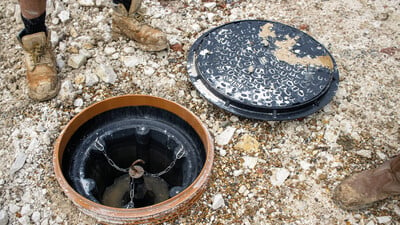Whether you are installing a manhole cover on a new drainage system or replacing or upgrading an existing manhole cover, this can seem a daunting task if you’ve never tried it before. But if you feel confident and would like to give it a go, here are a few hints and tips.
This blog post is, however, only intended to be a guide. We would always recommend using a building professional and if you decide to do it yourself, the responsibility is ultimately all yours.
Installing a manhole cover: where to start
Your first steps will depend on whether you are installing a new manhole cover or replacing an old one but either way, you want to start with a solid, level base that’s set at the correct height.
- If you are replacing a manhole cover, remove the old cover and frame and then repair or replace any loose brickwork around the top of the manhole chamber.
- Now check that the total area of the frame is the same as or larger than the chamber opening and that the frame can be properly aligned with the opening, with a border of at least 50mm between the frame that is clean, dry and clear of loose debris.
- The top surface of the chamber opening must have a texture that is rough enough to provide a key for the foundation mortar.
- Using your new manhole cover for reference, measure the distance between the top of the chamber opening and the finished ground level. If this is 80mm or more you will need to lay another course of bricks or add another shaft section. If it is 30mm or less, you can use only mortar to make up the difference. For any measurement between 30mm and 85mm, use packers and mortar to prepare for a mortar bed that will raise the top of the manhole cover to the finished height of the surrounding ground.
- In one even pass, lay a bed of mortar about 50mm wider than the frame. if there is insufficient space for this, use wedges to align the frame and manually pack the mortar under and around the frame.
- Place the manhole cover frame onto the mortar bed and fill any gaps under the frame with more mortar.
- Gently tap the manhole frame into the mortar bed until the top edge of the frame is within 5mm of the finished surface level.
- Add additional bedding mortar on top of the frame flange to a minimum depth of 10mm. Using suitable gloves, hand-pack this mortar until it has completely merged with any mortar that has squeezed out around the frame or through any gaps in its flange.
- If the manhole cover is to be set into asphalt, apply a brushed texture to the final mortar layer, as this will provide a key for subsequent surfacing materials.
- Before backfilling with road-fill materials, ensure the bedding mortar has cured before applying a heavy coat of bitumen-based cold joint sealer to the outside face of the frame and the inside face of the road surface.
- Complete the final surfacing according to recommendations and install the manhole cover in the frame.
Keeping a manhole clean during construction
Most construction sites create large amounts of dust, dirt and debris. If a manhole cover has been removed, damaged or dislodged, this can quickly lead to the manhole filling up and the drainage system becoming blocked.
A simple but effective solution to this problem is the MuckStopper an innovative product that acts as a further line of defence. Temporarily installed between the manhole and manhole cover, it is easily removed for access as required but prevents any dirt or debris from entering the manhole chamber, even if the manhole cover is compromised.
Once construction works are complete and before the final road surface is laid, the MuckStopper is easily removed and the manhole cover and frame are permanently reinstated. The MuckStopper can then be redeployed at a new location.
Maintaining a manhole
Particularly on busy roads, manholes and manhole covers are subjected to a lot of harsh treatment. Regular checks and maintenance are essential if they are to protect public safety and avoid damage to vehicles and the drainage system.
Even on private property, manholes should be kept in good condition to ensure the drains continue to work properly and to prevent issues with rodents, unpleasant smells and harmful bacteria. While manholes on public roads are generally the responsibility of a local council or highway department, those on private property may be the responsibility of the owner.
- A cracked or buckled manhole cover should be replaced as damage will affect its load-bearing capacity and could cause it to fail.
- Manhole covers should be regularly lifted to ensure they move freely and to inspect the manhole for damage and blockages.
- Check for cracks and loose pieces in the mortar, bricks or precast chamber sections, particularly around the top of the chamber. These can harbour bacteria, provide access to rodents and if dislodged, cause blockages.
- Check sewer manholes for evidence of blockages, as these are easier to fix before they get too serious. Run water through the system and see if it drains away too slowly; this can indicate an early obstruction. Minor blockages can often be cleared using drain rods but if these don’t work we advise calling in an expert drain cleaning company.
We hope you have found this information helpful and interesting. If you have any further questions, you are always welcome to call the friendly team of drainage experts at Drainfast on 01420 555600 or email [email protected].
Also, look out for more articles in our ongoing series of blog posts, bringing you useful information, insights, guides and tips on all things drainage!

Written by
Mark Chambers
Marketing Manager
As Marketing Manager, Mark plays an active role in running strategic projects to increase our brand profile.

